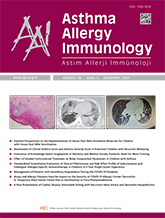


Objective: Anaphylaxis is a serious reaction that needs rapid intervention. However, some healthcare professionals may have inadequate knowledge about anaphylaxis to manage this situation. The aim of this study was to evaluate the level of knowledge about anaphylaxis in dentistry students (DS) in comparison with medical school ones (MS).
Materials and Methods: Students were recruited from the Dentistry (n=81) and Medical (n=144) Faculties of the University Hospital. The level of knowledge about anaphylaxis was evaluated by using a questionnaire with 26 items that was used previously.
Results: The overall response rate was 89.9%. One tenth of the study group had ever encountered a case with anaphylaxis, but 2.8% of them stated that they had involved in the treatment by themselves. Almost all of the participants stated that allergy might be a life-threatening reaction. Additionally, 43.3% reported that they had epinephrine in their department. DS knew less than MS about the primary use of epinephrine after assessing the airway, breathing and circulation in the treatment of anaphylaxis, and even in suspicious cases (59.3% vs. 98.6%, and 42% vs. 94.4%, all p<0.001). DS had significantly less knowledge about anaphylaxis treatment and epinephrine application than medical ones (all p <0.001). Furthermore, the information of that `the minimum duration for readministration of epinephrine as 10 minutes` was known by the half of MS, and one fourth of DS (p<0.001). The appropriate follow-up duration of patients with anaphylaxis was unknown in half of DS, and one fifth of MS (p<0.001). Even though MS had a higher rate of knowledge about the responsible and closest department dealing with anaphylaxis than dental students (p=0.02), DS were more aware of referring the patient with anaphylaxis to an allergy clinic (77.8% vs. 62.9%, p<0.001). Almost all MS had heard about the epinephrine auto-injector, in contrast to one third of the DS (p<0.001). Most of the participants, but mainly the MS knew that anaphylaxis could be diagnosed clinically. The case questions about diagnosis of anaphylaxis related to local anesthetic and beta-lactam antibiotic use were answered correctly in a higher rate in MS than DS (p=0.01 and p<0.001), whereas the rate of correct diagnosis of anaphylaxis following a bee sting was similar between the groups.
Conclusion: This study showed the gaps about the diagnosis and management of anaphylaxis not only in MS, but also in dentistry ones. It is possible to encounter a case of anaphylaxis for every student during clinical practice in the future. Thus, education about anaphylaxis should be included in the national dentistry core education programme and be improved in the medical school as well.